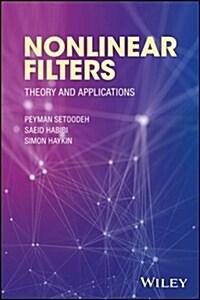책 이미지
![[eBook Code] Handbook on Array Processing and Sensor Networks](/img_thumb/9780470487051.jpg)
책 정보
· 분류 : 외국도서 > 과학/수학/생태 > 과학 > 파동/파동역학
· ISBN : 9780470487051
· 쪽수 : 924쪽
목차
Preface (Simon Haykin and K. J. Ray Liu).
Contributors.
Introduction (Simon Haykin).
PART I: FUNDAMENTAL ISSUES IN ARRAY SIGNAL PROCESSING.
1. Wavefields. (Alfred Hanssen).
1.1 Introduction.
1.2 Harmonizable Stochastic Processes.
1.3 Stochastic Wavefields.
1.4 Wave Dispersion.
1.5 Conclusions.
1.6 Acknowledgements.
References.
2. Spatial Spectrum Estimation (Petar M. Djurić).
2.1 Introduction.
2.2 Fundamentals.
2.3 Temporal Spectrum Estimation.
2.4 Spatial Spectrum Estimation.
2.5 Final Remarks.
References.
3. MIMO Radio Propagation (Tricia J. Willink).
3.1 Introduction.
3.2 Space-Time Propagation Environment.
3.3 Propagation Models.
3.4 Measured Channel Characteristics.
3.5 Stationarity.
3.6 Summary.
References.
4. Robustness Issues in Sensor Array Processing (Alex B. Gershman).
4.1 Introduction.
4.2 Direction-of-Arrival Estimation.
4.3 Adaptive Beamforming.
4.4 Conclusions.
Acknowledgments.
References.
5. Wireless Communication and Sensing in Multipath Environments Using Multiantenna Transceivers (Akbar M. Sayeed and Thiagarajan Sivanadyan).
5.1 Introduction and Overview.
5.2 Multipath Wireless Channel Modeling in Time, Frequency and Space.
5.3 Point-to-Point MIMO Wireless Communication Systems.
5.4 Active Wireless Sensing with Wideband MIMO Transceivers.
5.5 Concluding Remarks.
References.
PART II: NOVEL TECHNIQUES FOR AND APPLICATIONS OF ARRAY SIGNAL PROCESSING.
6. Implicit Training and Array Processing for Digital Communication Systems (Aldo G. Orozco-Lugo, Mauricio Lara, and Desmond C. McLernon).
6.1 Introduction.
6.2 Classification of Implicit Training Methods.
6.3 IT-Based Estimation for a Single User.
6.4 IT-Based Estimation for Multiple Users Exploiting Array Processing: Continuous Transmission.
6.5 IT-Based Estimation for Multiple Users Exploiting Array Processing: Packet Transmission.
6.6 Open Research Problems.
Acknowledgments.
References.
7. Unitary Design of Radar Waveform Diversity Sets (Michael D. Zoltowski, Tariq R. Qureshi, Robert Calderbank, and Bill Moran).
7.1 Introduction.
7.2 2 x 2 Space-Time Diversity Waveform Design.
7.3 4 x 4 Space-Time Diversity Waveform Design.
7.4 Waveform Families Based on Kronecker Products.
7.5 Introduction to Data-Dependent Waveform Design.
7.6 3 x 3 and 6 x 6 Waveform Scheduling.
7.7 Summary.
References.
8. Acoustic Array Processing for Speech Enhancement (Markus Buck, Eberhard Hänsler, Mohamed Krini, Gerhard Schmidt and Tobias Wolff).
8.1 Introduction.
8.2 Signal Processing in the Subband Domain.
8.3 Multichannel Echo Cancelation.
8.4 Speaker Localization.
8.5 Beamforming.
8.6 Sensor Calibration.
8.7 Postprocessing.
8.8 Conclusions.
References.
9. Acoustic Beamforming for Hearing Aid Applications (Simon Doclo, Sharon Gannot, Marc Moonen and Ann Spriet).
9.1. Introduction.
9.2. Overview of noise reduction techniques.
9.3. Monaural beamforming.
9.4. Binaural beamforming.
9.5. Conclusion.
10. Undetermined Blind Source Separation Using Acoustic Arrays (Shoji Makino, Shoko Araki, Stefan Winter and Hiroshi Sawada).
10.1 Introduction.
10.2 Underdetermined Blind Source Separation of Speeches in Reverberant Environments.
10.3 Sparseness of Speech Sources.
10.4 Binary Mask Approach to Underdetermined BSS.
10.5 MAP-Based Two-Stage Approach to Underdetermined BSS.
10.6 Experimental Comparison with Binary Mask Approach and MAP-Based Two-Stage Approach.
10.7 Concluding Remarks.
References.
11. Array Processing in Astronomy (Douglas C.-J. Bock).
11.1 Introduction.
11.2 Correlation Arrays.
11.3 Aperture Plane Phased Arrays.
11.4 Future Directions.
11.5 Conclusion.
References.
12. Digital 3D/4D Ultrasound Imaging Array (Stergios Stergiopoulos).
12.1 Background.
12.2 Next Generation 3D/4D Ultrasound Imaging Technology.
12.3 Computing Architecture and Implementation Issues.
12.4 An Experimental Planar Array Ultrasound Imaging System.
12.5 Conclusion.
References.
PART III: FUNDAMENTAL ISSUES IN DISTRIBUTED SENSOR NETWORKS.
13. Self-Localization of Sensor Networks (Josh N. Ash and Randolph L. Moses).
13.1 Introduction.
13.2 Measurement Types and Performance Bounds.
13.3 Localization Algorithms.
13.4 Relative and Transformation Error Decomposition.
13.5 Conclusions.
References.
14. Multitarget Tracking and Classification in Collaborative Sensor Networks via Sequential Monte Carlo (Tom Vercauteren and Xiaodong Wang).
14.1 Introduction.
14.2 System Description and Problem Formulation.
14.3 Sequential Monte Carlo Methods.
14.4 Joint Single-Target Tracking and Classification.
14.5 Multiple-Target Tracking and Classification.
14.6 Sensor Selection.
14.7 Simulation Results.
Conclusion.
Appendix: Derviations of (14.38 and (14.40).
References.
15. Energy-Efficient Decentralized Estimation (Jin-Jun Xiao, Shuguang Cui and Zhi-Quan Luo).
15.5 Introduction.
15.2 System Model.
15.3 Digital Approaches.
15.4 Analog Approaches.
15.5 Analog versus Digital.
15.6 Extension to Vector Model.
15.7 Concluding Remarks.
Acknowledgments.
References.
16. Sensor Data Fusion with Application to Multitarget Tracking (R. Tharmarasa, K. Punithakumar, T. Kirubarajan and Y. Bar-Shalom).
16.1 Introduction.
16.2 Tracking Filters.
16.3 Data Association.
16.4 Out-of-Sequence Measurements.
16.5 Results with Real Data.
16.6 Summary.
References.
17. Distributed Algorithms in Sensor Networks (Usman A. Khan, Soummya Kar and José Moura).
17.1 Introduction.
17.2 Preliminaries.
17.3 Distributed Detection.
17.4 Consensus Algorithms.
17.5 Zero-Dimension (Average) Consensus.
17.6 Consensus in Higher Dimensions.
17.7 Leader-Follower (Type) Algorithms.
17.8 Localization in Sensor Networks.
17.9 Linear System of Equations: Distributed Algorithm.
17.10 Conclusions.
References.
18. Cooperative Sensor Communications (Ahmed K. Sadek, Weifeng Su and K. J. Ray Liu).
18.1 Introduction.
18.2 Cooperative Relay Protocols.
18.3 SER Analysis and Optimal Power Allocation.
18.4 Energy Efficiency in Cooperative Sensor Networks.
18.5 Experimental Results.
18.6 Conclusions.
References.
19. Distributed Source Coding (Zixiang Xiong, Angelos D. Liveris and Yang Yang).
19.1 Introduction.
19.2 Theoretical Background.
19.3 Code Designs.
19.4 Applications.
19.5 Conclusions.
References.
20. Network Coding for Sensor Networks (Christina Fragouli).
20.1 Introduction.
20.2 How Can We Implement Network Coding in a Practical Sensor Network?
20.3 Data Collection and Coupon Collector Problem.
20.4 Distributed Storage and Sensor Network Data Persistence.
20.5 Decentralized Operation and Untuned Radios.
20.6 Broadcasting and Multipath Diversity.
20.7 Network, Channel and Source Coding.
20.8 Identity-Aware Sensor Networks.
20.9 Discussion.
Acknowledgments.
References.
21. Information-Theoretic Studies of Wireless Sensor Networks (Liang-Liang Xie and P. R. Kumar).
21.1 Introduction.
21.2 Information-Theoretic Studies.
21.3 Relay Schemes.
21.4 Wireless Network Coding.
21.5 Concluding Remarks.
Acknowledgments.
References.
PART IV: NOVEL TECHNIQUES FOR AND APPLICATIONS OF DISTRIBUTED SENSOR NETWORKS.
22. Distributed Adaptive Learning Mechanisms (Ali H. Sayed and Federico S. Cattivelli).
22.1 Introduction.
22.2 Motivation.
22.3 Incremental Adaptive Solutions.
22.4 Diffusion Adaptive Solutions.
22.5 Concluding Remarks.
Acknowledgments.
References
23. Routing for Statistical Inference in Sensor Networks (A. Anandkumar, A. Ephremides, A. Swami and L. Tong).
23.1 Introduction.
23.2 Spatial Data Correlation.
23.3 Statistical Inference of Markov Random Fields.
23.4 Optimal Routing for Inference with Local Processing.
23.5 Conclusion and Future Work.
23.6 Bibliographic Notes.
References.
24. Spectral Estimation in Cognitive Radios (Behrouz Farhang-Boroujeny).
24.1 Filter Bank Formulation of Spectral Estimators.
24.2 Polyphase Realization of Uniform Filter Banks.
24.3 Periodogram Spectral Estimator.
24.4 Multitaper Spectral Estimator.
24.5 Filter Bank Spectral Estimator.
24.6 Distributed Spectrum Sensing.
24.7 Discussion.
Appendix A: Effective Degree of Freedom.
Appendix B: Explanation to the Results of Table 24.1.
References.
25. Nonparametric Techniques for Pedestrian Tracking in Wireless Local Area Networks (Azadeh Kushki and Kostas N. Plataniotis).
25.1 Introduction.
25.2 WLAN Positioning Architectures.
25.3 Signal Models.
25.4 Zero-Memory Positioning.
25.5 Dynamic Positioning Systems.
25.6 Cognition and Feedback.
25.7 Tracking Example.
25.8 Conclusions.
References.
26. Reconfigurable Self-Activating Ion-Channel-Based Biosensors Vikram Krishnamurthy and Bruce Cornell).
26.1 Introduction.
26.2 Biosensors Built of Ion Channels.
26.3 Joint Input Excitation and Concentration Classification for Biosensor.
26.4 Decentralized Deployment of Dense Network of Biosensors.
26.5 Discussion and Extensions.
References.
27. Biochemical Transport Modeling, Estimation and Detection in Realistic Environments (Mathias Ortner and Arye Nehorai ).
27.1 Introduction.
27.2 Physical and Statistical Models.
27.3 Transport Modeling Using Monte Carlo Approximation.
27.4 Localizing the Source(s).
27.5 Sequential Detection.
27.6 Conclusion.
References.
28. Security and Privacy for Sensor Networks (Wade Trappe, Peng Ning and Adrian Perrig).
28.1 Introduction.
28.2 Security and Privacy Challenges.
28.3 Ensuring Integrity of Measurement Process.
28.4 Availability Attacks against the Wireless Link.
28.5 Ensuring Privacy of Routing Contexts.
28.6 Conclusion.
References.
Index.













![[eBook Code] Handbook on Array Processing and Sensor Networks](./img_thumb/9780470487051.jpg)






![[eBook Code] Fundamentals of Cognitive Radio (eBook Code, 1st)](/img_thumb/9781119405832.jpg)










